Tech Portal
Tech Portal
Next steps for the pioneers of 10GigE, 25GigE, and 100GigE
Any Speed
Speeds like 10GigE, 25GigE, and 100GigE are a must have in many applications. However, as we launch our new Eros 10GigE line of cameras in 2024, we will be leveraging our deep experience in performance applications to reliably support 10GigE, 5GigE and lower speeds in 1 or many camera per server applications with a wide variety of performance processing options in the same zero copy / zero loss sense.
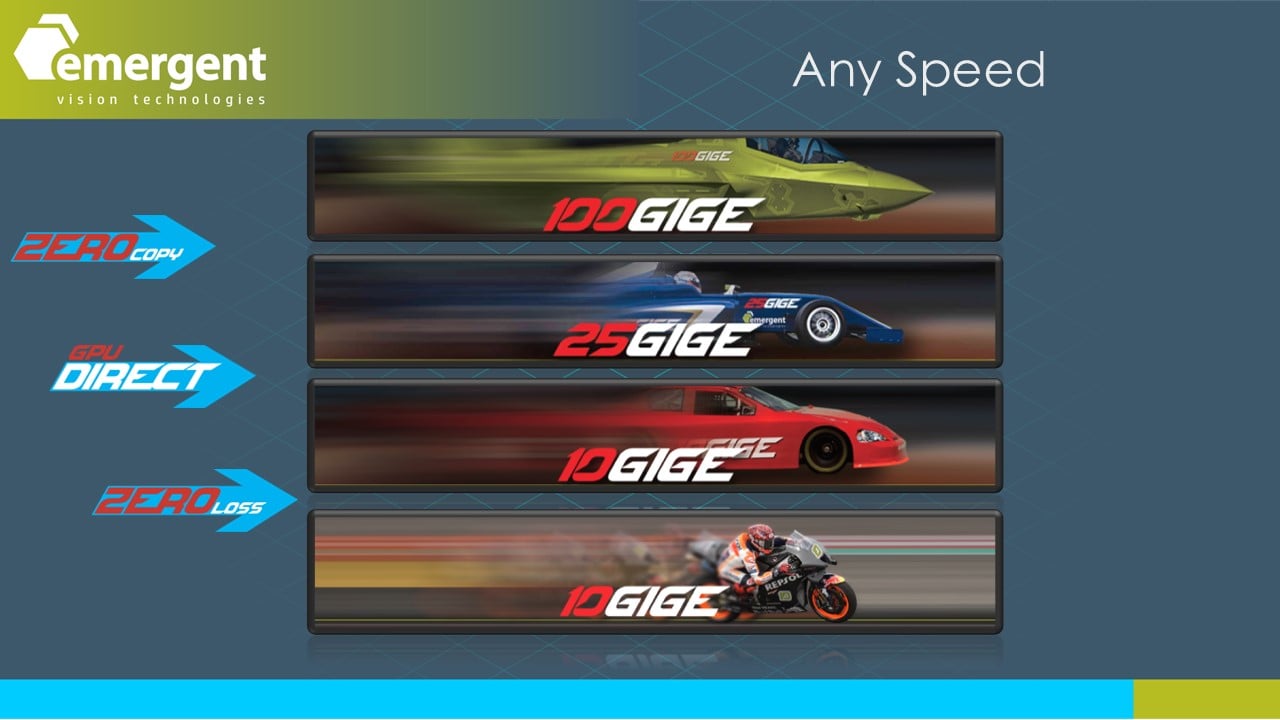
Figure: Emergent camera line, designed for high-performance applications with reliable support at 100GigE, 25GigE & 10GigE speeds.
EROS – 5GigE Area Scan Cameras
As we go to full production with our new Eros 10GigE line of cameras in Q1 of 2025, we will introduce many of the same sensors we already support but now in lower speed, lower cost, and much smaller size options. SWIR is also coming to the Eros product line in the same timeframe.
As we presented at the recent Vision show in Germany, we have the Eros camera line operating at 10G speeds now and for the RJ45 POE version the cameras can autonegotiate to 5G, 2.5G, and 1G for lower speed operations. We do all this in an attractive 29x29mm form-factor. This is all made possible by the lowest power consumption of all 10GigE and 5GigE cameras of all manufacturers in the industry. In fact, the Eros operating at 10GigE with POE has lower power consumption than any 5GigE camera in the industry. And very noteworthy is the feature set is not reduced compared to other models and Emergent’s same reliable and mature zero-copy and GPU Direct solutions are available for an overall solution which is second to none.
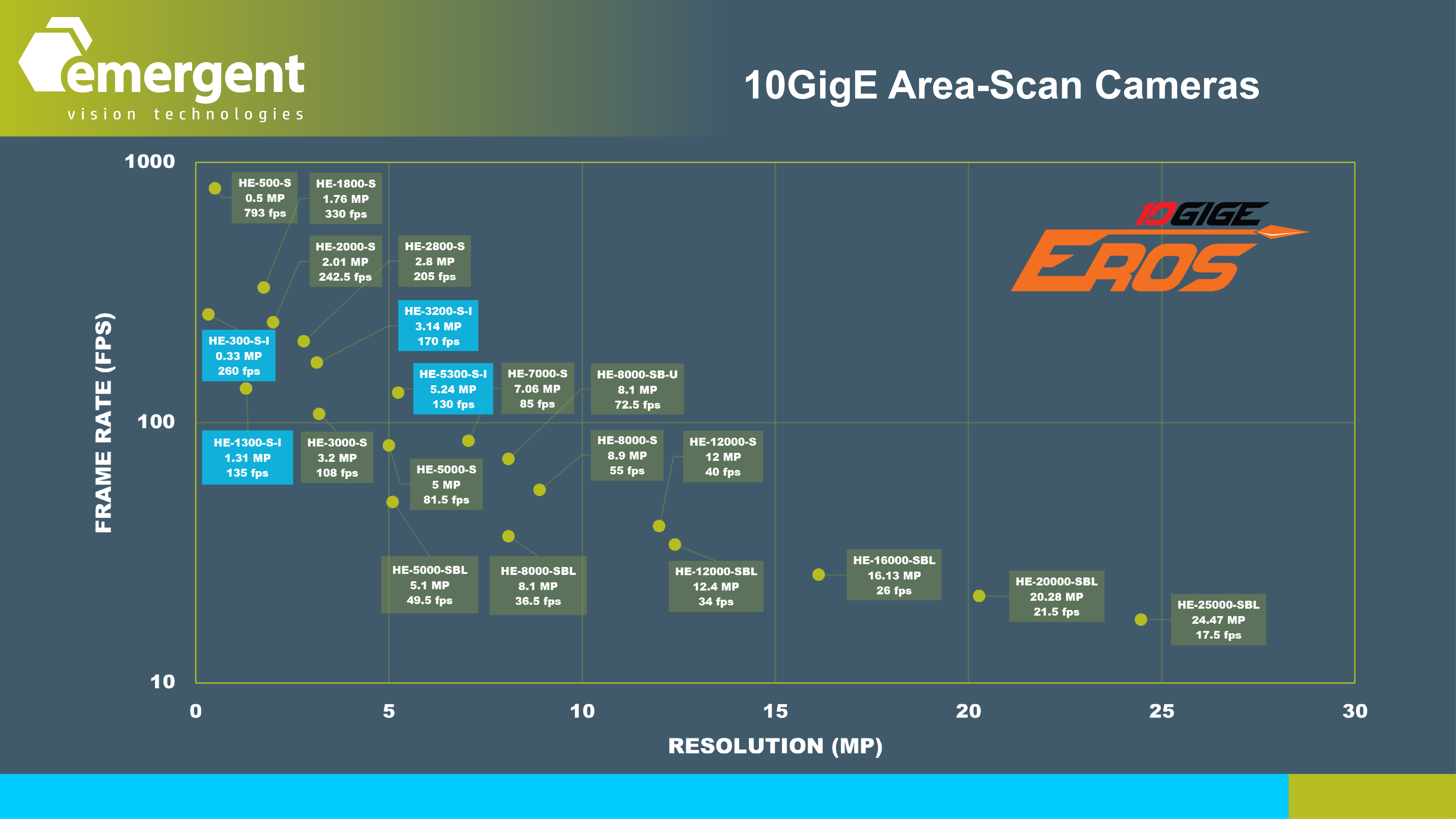
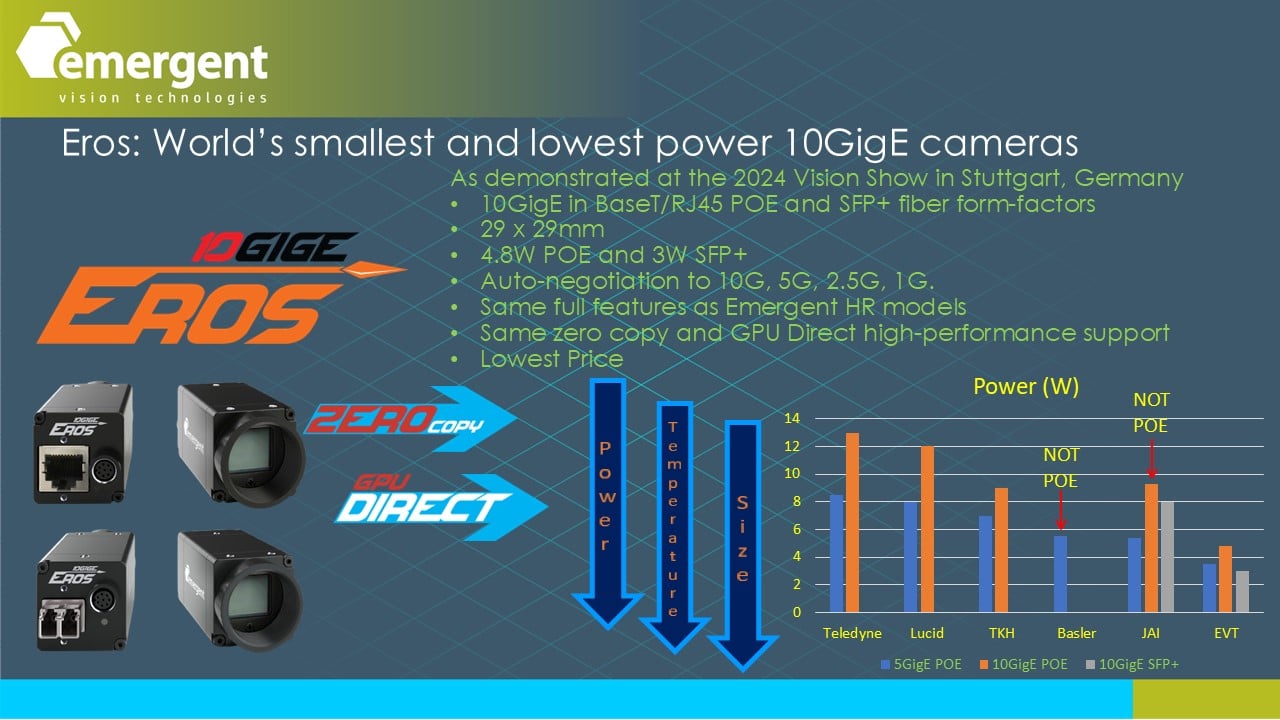
Figure (top): FPS vs. MP for Eros cameras, highlighting performance across different resolutions and frame rates.
Figure (bottom):The low power consumption of the Eros 10GigE cameras compared to other 5GigE models.
Upcoming New models
While Emergent has been shipping 100GigE cameras for over 4 years, the sensors, while still very good, were front illuminated. Not only has Sony announced sensors now capable of 100GigE speeds but these will also follow their gen 4 pixel architecture which is based on back-side illuminated sensor technologies which allow very high quantum efficiencies for greater sensitivities which is a great benefit when going ultra high frame rates where exposures need to be kept shorter. GPixel has also announced a 14MP BSI sensor. Both will be released in Emergent Zenith 100GigE models in 2025.
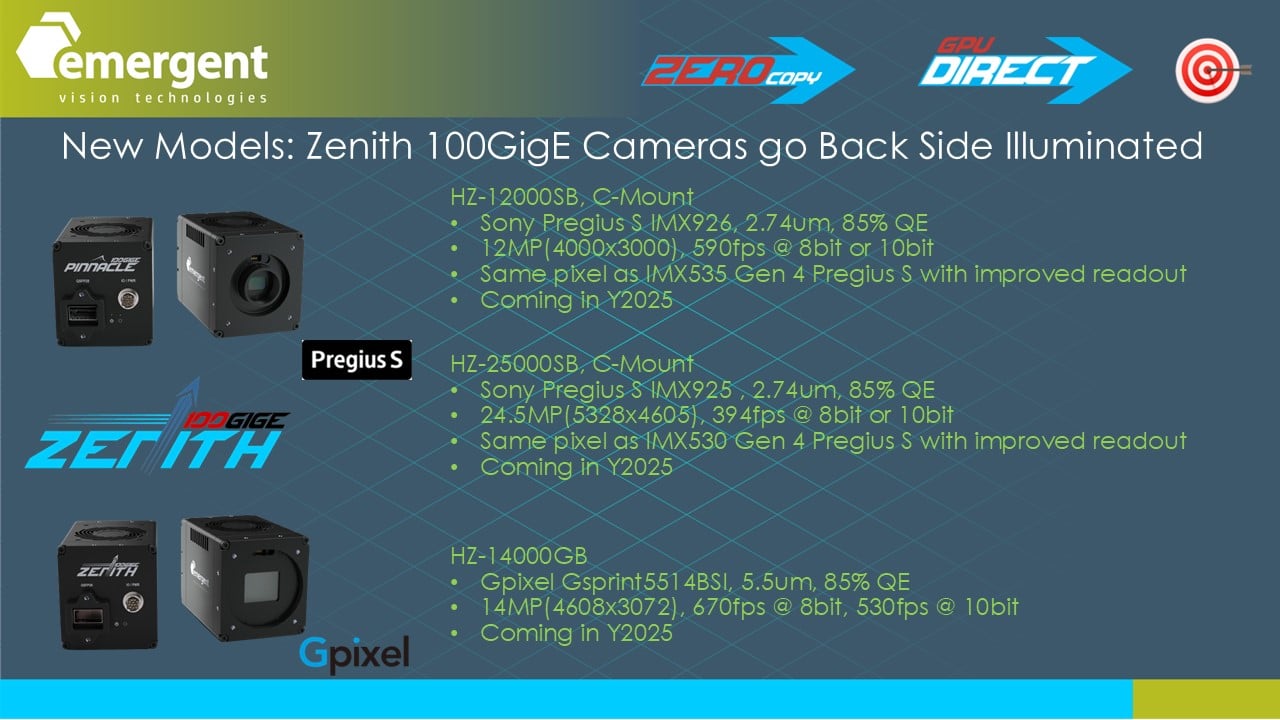
Figure: Upcoming Emergent Zenith 100GigE cameras in 2025 will feature new back-side illuminated (BSI) sensors for improved sensitivity and ultra-high frame rates.
Trade Show
Firstly, for all those who visited our booth at the recent Vision Show in Germany, a big thank-you from the Emergent team. For those who missed us at the Vision Show we give here a short personal tour. We scaled up our booth substantially and spared no expense to make sure you could see first hand what gets our customers so excited. We hope to see you all at a trade show near you.
In the first demo, we had a single server running 3 Line Scan 100GigE cameras showing the use of GigEVision 3.0 RDMA RoCEv2 – fastest in the market.
In the second demo, we had a single Intel desktop server with GPU Direct and Machine learning defect detection running 4 25GigE cameras and 4 10GigE Eros cameras which are the smallest and lowest power in the market.
In the third demo, we had a single server with GPU direct and real-time reconstruction from 36 10GigE cameras.
In the fourth demo, we had 2 servers and 8 25GigE cameras showing our FlexProc and FlexTrans technologies which allow zero copy movement of data to and from anywhere in the system which benefits customers who need to distribute processing to other resources when processing bottlenecks appear.
In the fifth demo, we had a single NVidia Orin IGX sever with GPU direct and real-time fisheye image remapping using 2 100GigE HZ-65000G 65MP cameras running at 71fps.
Video showcasing Emergent’s demos at the Vision Show, including high-performance 100GigE and 25GigE cameras, GPU Direct, Machine Learning, and FlexProc technologies.
Mini Case Study – Sanovo
We are going to take a look at a few case studies now. We will start with Sanovo Technology Group which is an excellent example of how Emergent technology and support can help level-up a system both in price and performance. We see the Emergent first aid kit which is always in indication that a customer has worked with and failed to realize their goals with the top cameara manufacturers in the industry. At this point, Sanovo turned to Emergent having never worked with us before. Sanovo was shy to purchase immediately after being forced to buy and test cameras from the other manufacturers for their desired configuration. Shockingly (or maybe not so shocking), Sanovo was not able to achieve stability with 1/4 of the desired camera quantity. At Emergent, we were so confident we could fulfill their needs that we offered a money back gurantee on a turn-key system including 21 cameras, server, switch, NICs, GPUs, etc. We used eCapture Pro to prototype the configuration and delivered this to Sanovo where they promptly approved and then began writing their final application with the Emergent eSDK.
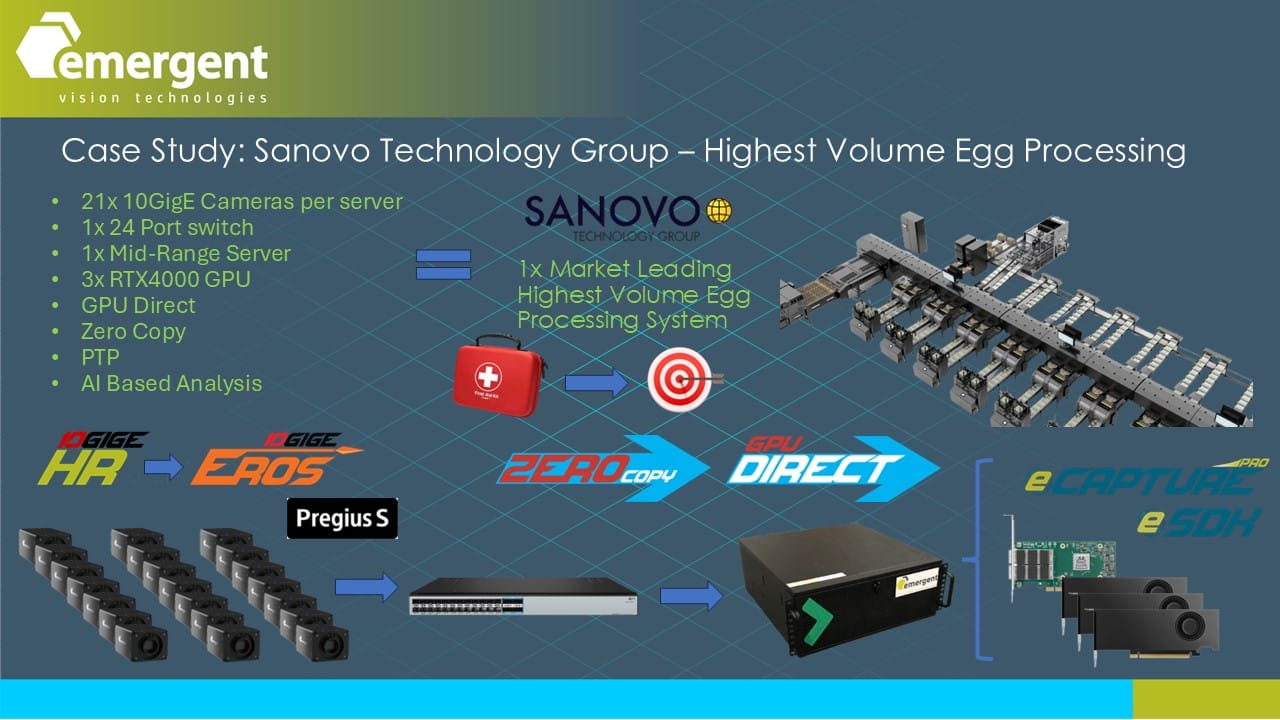
Figure: Case study on how Emergent helped Sanovo achieve stable, high-performance camera systems using eCapture Pro and eSDK.
Mini Case Study – Norfolk Southern
The next case study is another excellent example of how Emergent helped level-up a system both in price and performance. Norfolk started working with one of the usual top camera manufacturers with their 10GigE cameras for their multi-camera rail-car inspection application. This was the same camera manufacture that typically does not test their 10GigE cameras in more than 2 per server. Predictably, Norfolk has issues with stability in low camera counts. Not only did Emergent technologies allow Norfolk to meet their initial goals but also allowed them to surpass these goals by moving to higher frame rates with our 25GigE Bolt cameras for an overall system performance improvement.
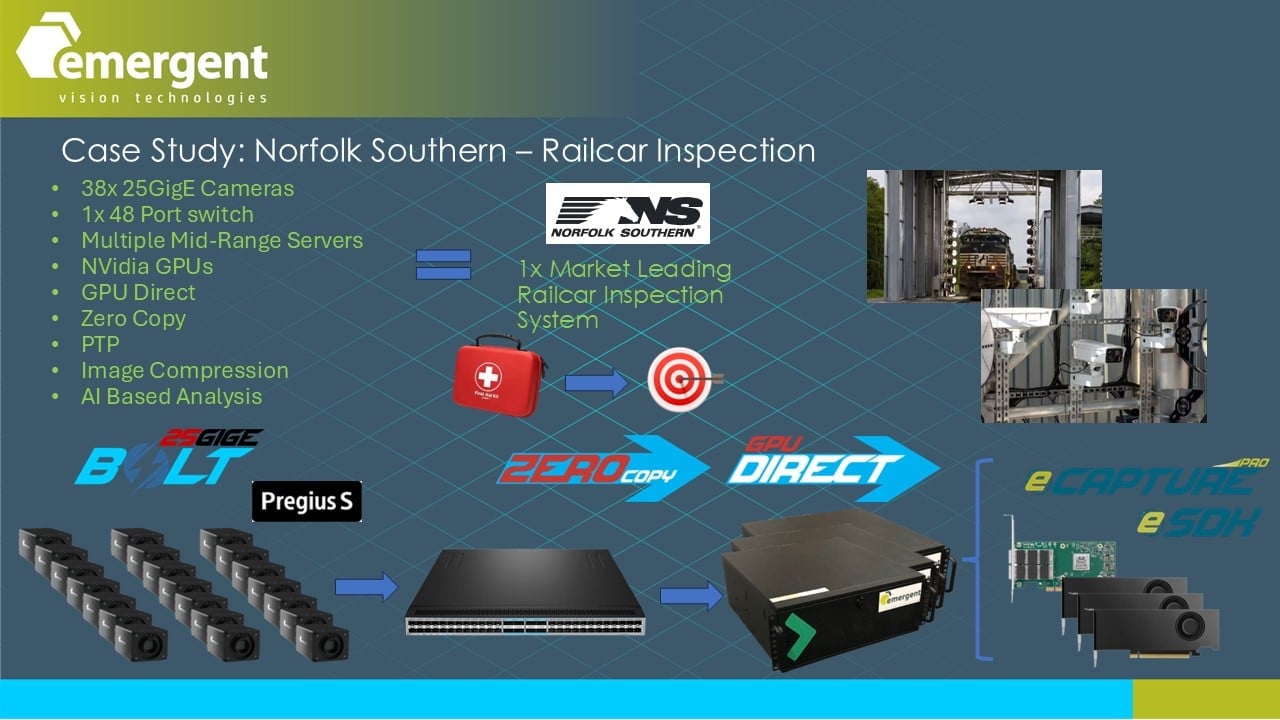
Figure: Case study on how Emergent helped Norfolk overcome stability issues and surpass performance goals with 25GigE Bolt cameras for rail-car inspection.
Mini Case Study – Hawkeye
One of our longest standing customers is Hawkeye which is owned by Sony. Another long standing customers in sports analytics is Kinatrax which is now also owned by Sony. These are 2 of many Emergent customers who are in the sports analytics fields and the sports are wide varying and covering all the major sports leagues. 10+ years ago we were supporting systems of up to 16 10GigE cameras per server with zero copy and reliable performance
and performance has only grown since then thanks to the advancements in CPU, memory, and GPU technologies. One of the most interesting applications was developed by Sony Hawkeye in the way of baseball seam tracking which allows them to determine the spin on the ball and ultimately allow them to determine virtually in real time what type of pitch was thrown. Hawkeye is now working with our Zenith HZ-10000G 100GigE cameras with a frame rate of up to 1000 at its full resolution of 10MP.
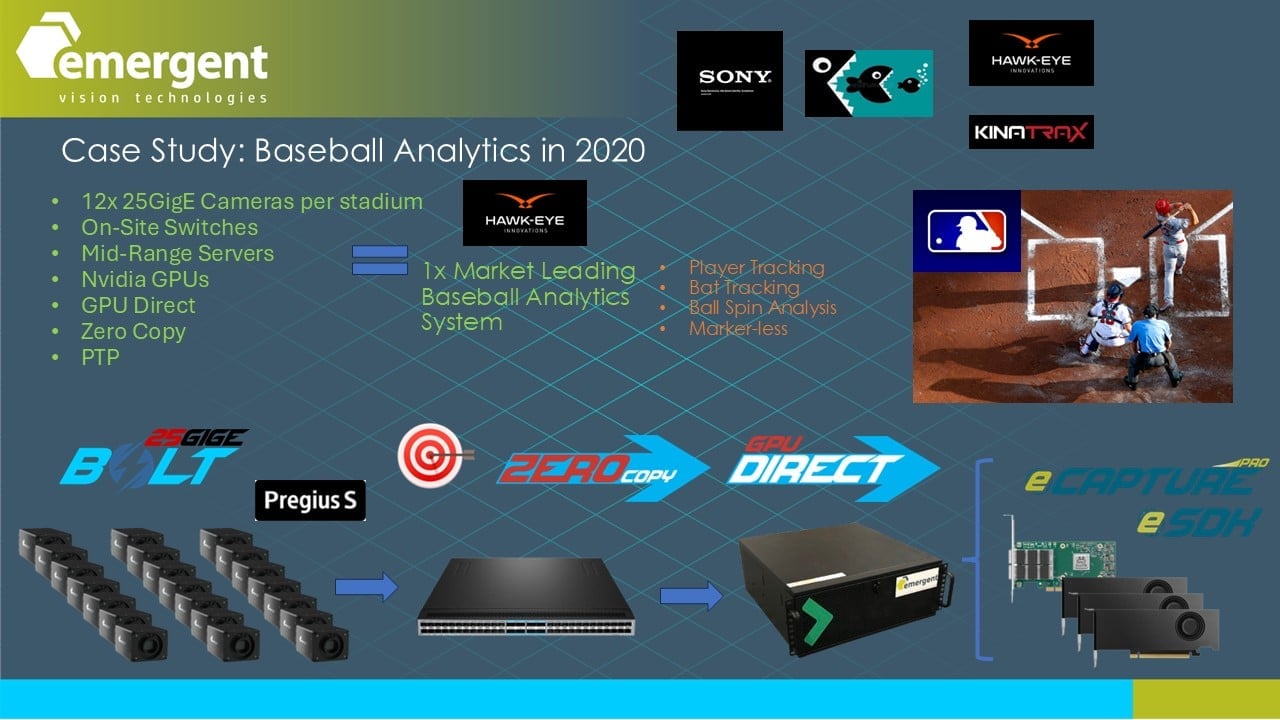
Figure: Case study on how Emergent supported Hawkeye and Kinatrax in sports analytics, enabling high-performance systems with up to 100GigE cameras for baseball seam tracking and other applications.
Mini Case Study – Advanced Research Center for Nanolithography (ARCNL)
Smaller high end laboratory setups make use of our Zenith 100GigE cameras as well. ARNCL (or the Advanced Research Center for Nanolithography) has successfully used the Emergent Zenith 100GigE HZ-2000G 2MP camera for experimental interferometric and vibration measurement in DHM (digital holographic microscopy). Small semiconductor wafer fragments were used as part of the experiment. Compact size, GPU Direct, low latency, reliable transfer and overall performance were key in the selection of the Emergent camera.
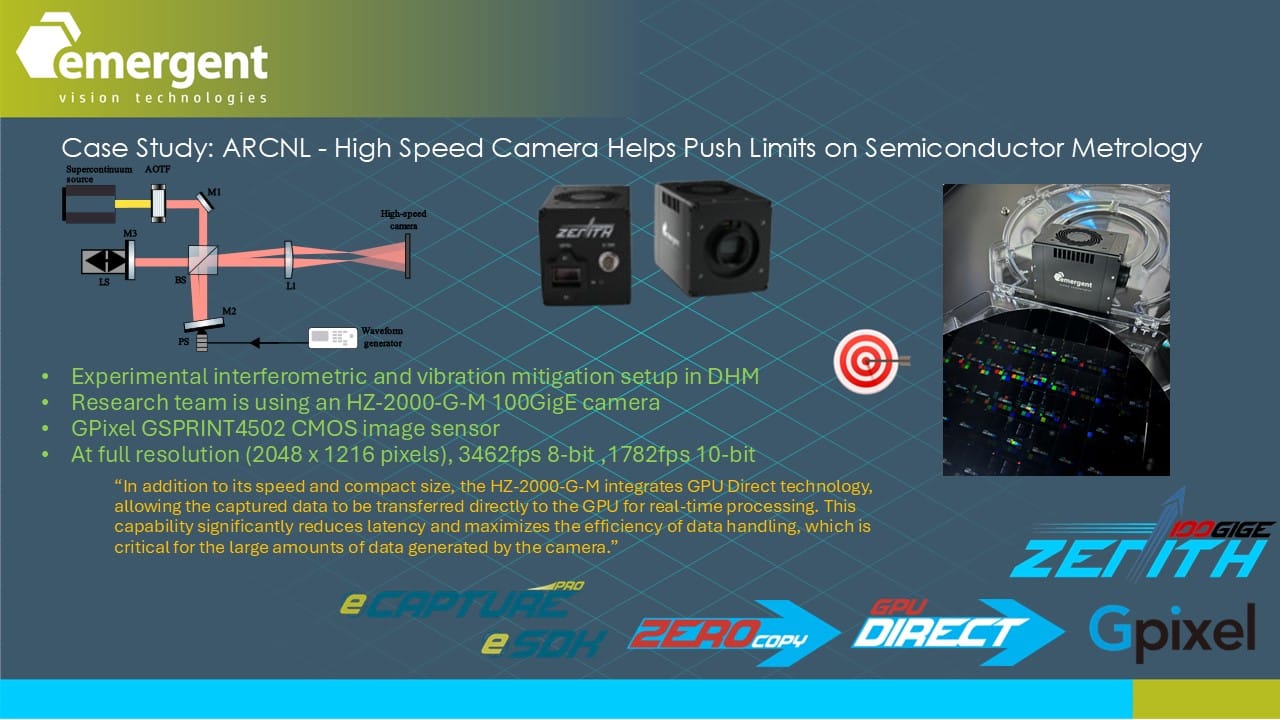
Figure: Case study on how ARNCL used Emergent Zenith 100GigE HZ-2000G cameras for interferometric and vibration measurement in digital holographic microscopy.
Mini Case Study – Wind Tunnel Monitoring
While Emergent cameras are finding their way into many Wind Tunnel monitoring systems, one of the highest performance systems is using 16 Zenith HZ 21000G 100GigE cameras which uses multiple servers and a single 100GigE switch for PTP and stream routing to the various servers which house GPU processing resources. Long cable lengths are a big benefit but very important also is the quality and consistency of the camera product.
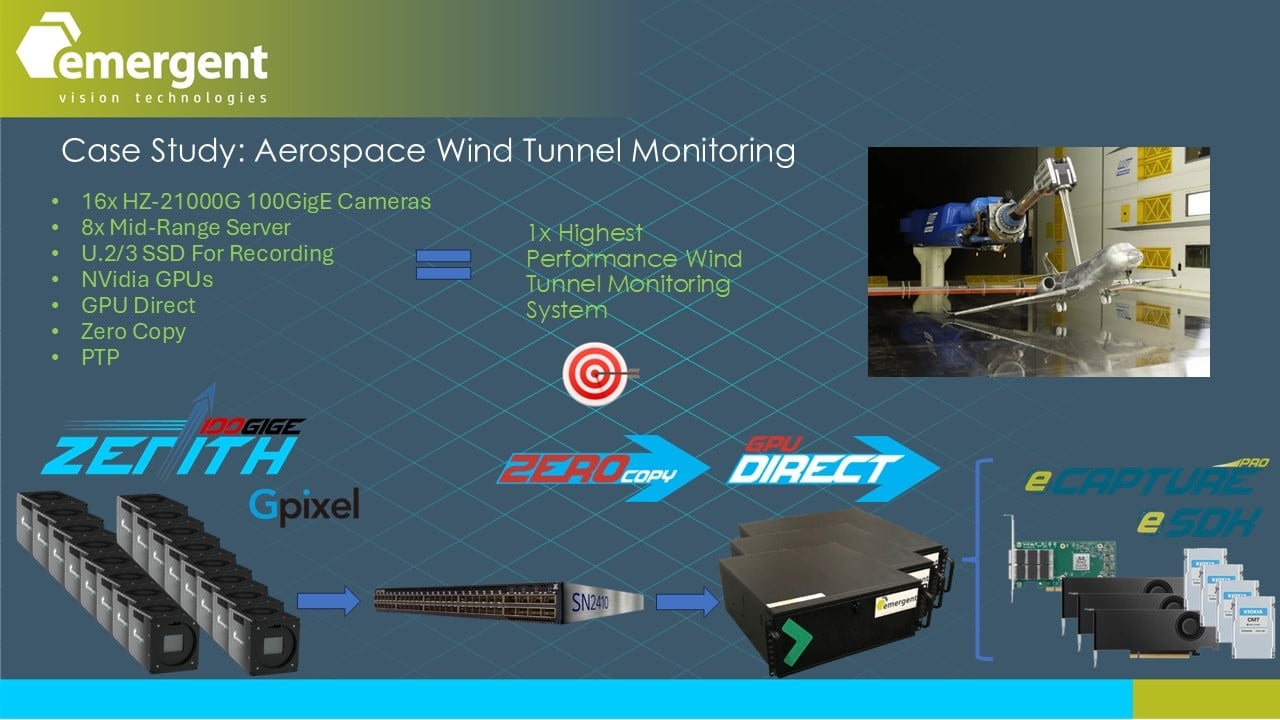
Figure: Case study on how Emergent Zenith HZ-21000G cameras are used in high-performance wind tunnel monitoring systems, with multiple servers and a 100GigE switch for GPU processing.
Mini Case Study – AOI Inspection
AOI applications are often striving for higher resolution and with this must come an accetable frame rate. One such AOI customer utilized 2 Zenith 100GigE HZ-65000G 65MP cameras with its top frame rate of 71fps. As always the case, customers rely on either zero-copy performance in saving data to disk or the ability to use GPU Direct to get immediate access and real-time processing capabilities to realize maximum performance and throughput in their systems.
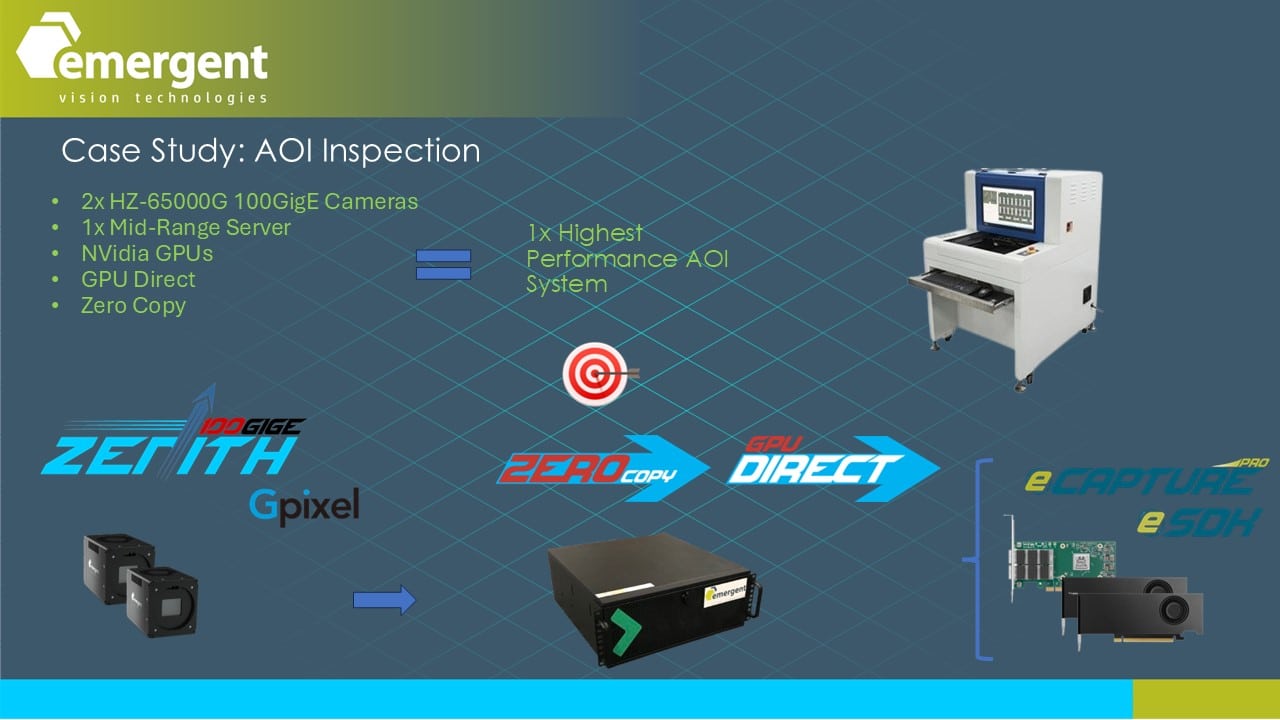
Figure: Case study on how an AOI customer achieved high resolution and frame rates using 2 Zenith 100GigE HZ-65000G 65MP cameras with zero-copy performance and GPU Direct for real-time processing.
Mini Case Study – Battery Foil Inspection
Of course, all the benefits Emergent brings with area-scan cameras are also just as relevant to line-scan cameras. With the explosion of electric vehicles on the market comes the need for higher performance inspection of critical components of these vehicles and, here, no component is more critical than the battery itself. Emergent is engaged with many customers in this space and the Pinnacle 100GigE LZ-16KG5 and LZT-9KG5 TDI cameras are a perfect fit. The 16K 400KHz LZ-16KG5 is a great choice to decrease the number of line scan cameras to scan the full foil width while the 9K 600KHz TDI LZT-9KG5 camera is great choice for applications which are more light starved or which need to run at higher rates without changing the light levels. Of course, Emergent has lower performance line scan models where needed.

Figure: Case study on how Emergent Pinnacle 100GigE LZ-16KG5 and LZT-9KG5 TDI cameras are used for high-performance inspection of electric vehicle battery components.
Mini Case Study – Volumetric Capture
One of Emergent’s initial work in Volumetric Capture was with the Intel Studio’s group. For their system, we supplied 100 Emergent 25GigE Bolt 50MP cameras and wrote the capture software and UI front end which later formed the basis of our current eCapture Pro. We also assisted in switch and server configuration as well as remote troubleshooting to get the system fully functional and stable – a service we provide all our customers. In parallel, we were working with a significant customer who started working with our 10GigE cameras but later, as our Bolt 25GigE cameras came out with the new Sony Pregius S sensors, they quickly shifted to these models. The systems started with lower camera counts of a 100 or so but later evolved into systems comprised of upwards of 500 25GigE Bolt cameras in multiple locations. On a side note, this is one customer that heavily relies on multi-cast technologies which are not available with RDMA and RoCEv2 nor CXP – distributed processing and redundancy are critical factors for many systems both big and small.
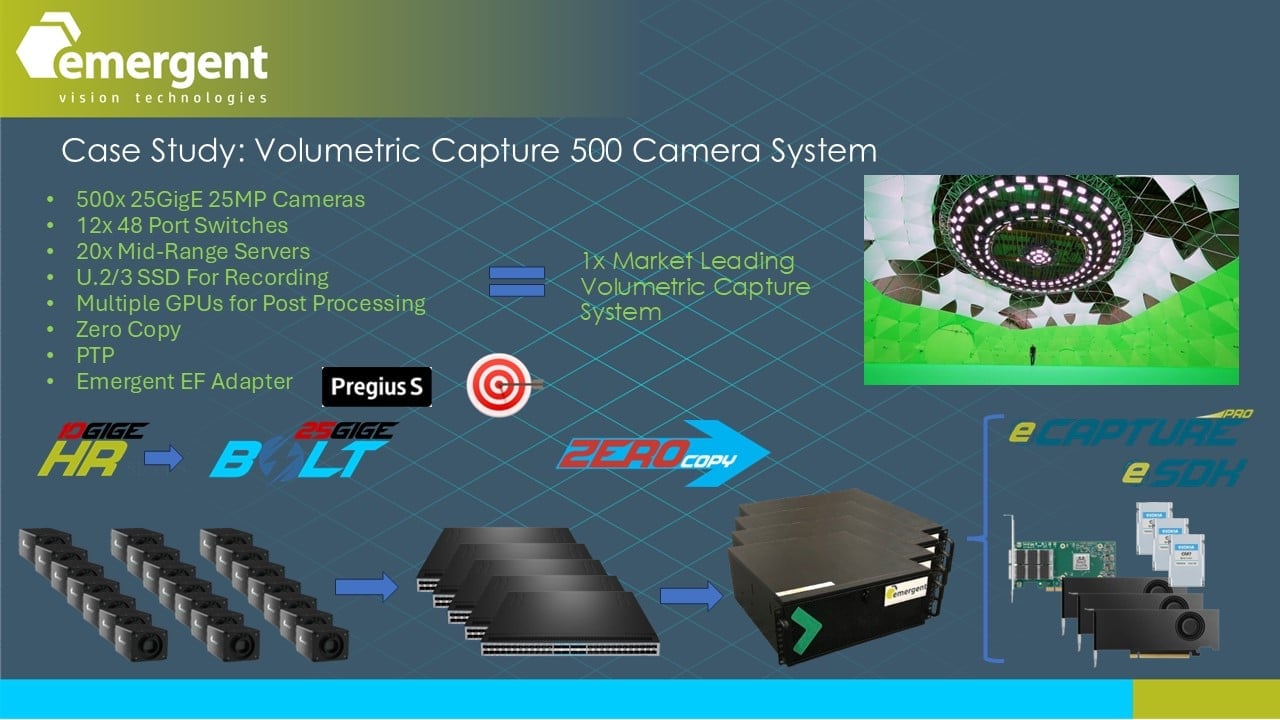
Figure: Case study on Emergent’s work with Intel Studios and a major customer, supplying 25GigE Bolt 50MP cameras for volumetric capture and system configuration, with a focus on distributed processing and redundancy.
FPGA options RDMA/RoCEv2 vs GVSP
What we see is that RoCEv2 requires more FPGA resources to implement and as such the cost of the FPGA will be higher than that of the lightweight standard and mature GigEVision GVSP protocol. This is even moreso true if a resend buffer is implemented. We see that in order to create the smallest and lowest cost camera that these cameras from various manufacturers are not supporting RoCEv2 below 10GigE and some not below 25GigE. This is one way in which Emergent’s new Eros 10GigE offering will continue to provide true ZERO copy performance while the others rely on TCP and convential GVSP processing which yields 3x memory bandwidth and 33% efficiency of the Emergent ZERO copy methods. In multi-camera systems, Emergent will remain unmatched in system density and price performance metrics. And remember, that while many state low CPU utilization that it is actually memory bandwidth utilization that is hiding in the background and preventing maximal system performance.
All GigE Paths lead to Emergent
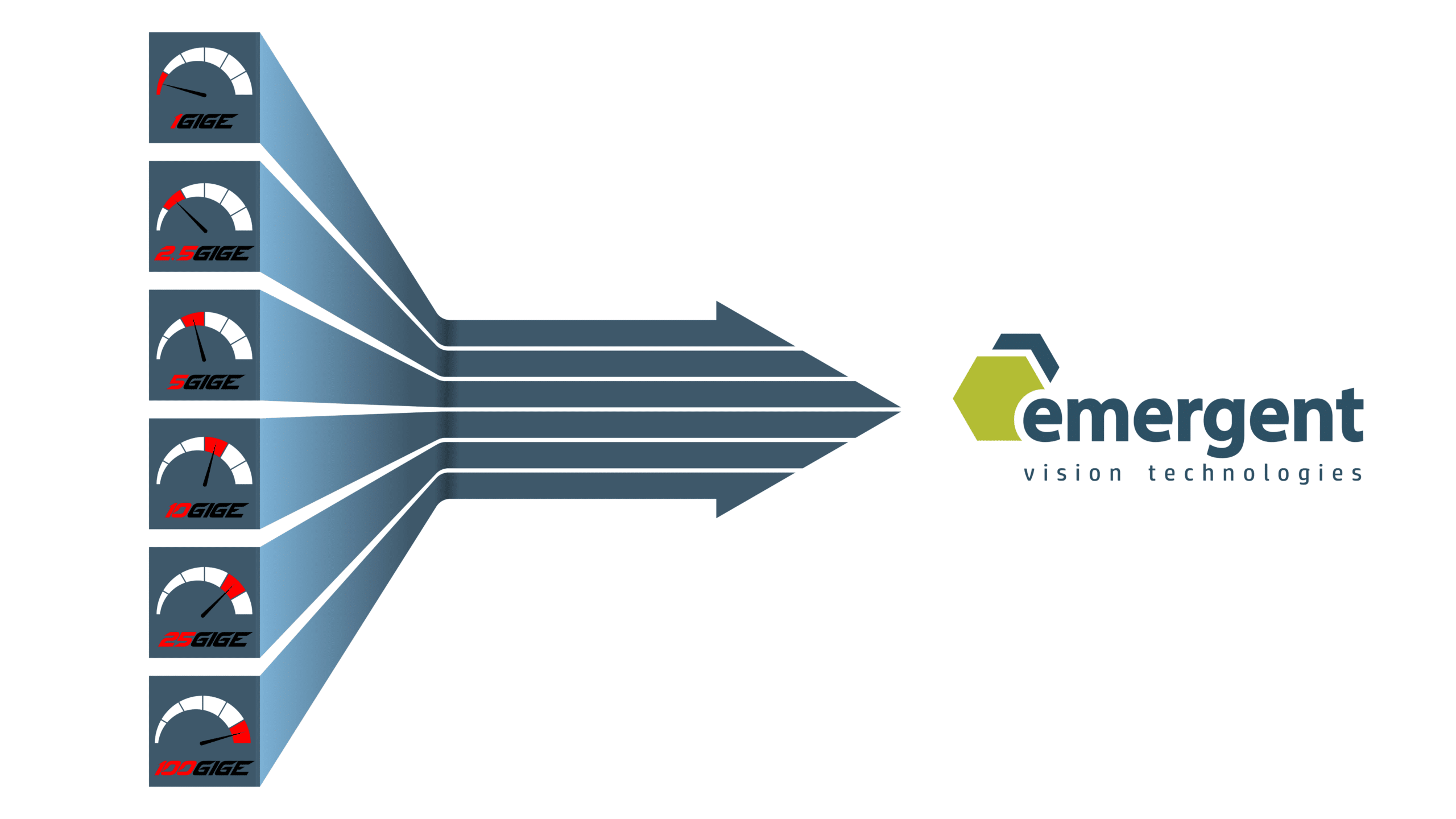
Figure: All GigE paths lead to Emergent.
Worth noting that all of the preceding systems have been provided without GigEVision 3 ROCEv2 but rather Emergent’s very mature driver technology was employed in ways not unlike the very common filter drivers for GigEVision cameras we have all become accustomed to. The main difference is our drivers are fully zero copy. Any NIC that supports ROCEv2 can also support generalized zero copy needed for GigEVision GVSP. ROCEv2 drivers will all still be proprietary like filter drivers and some will be better than others. With ROCEv2, it is really only the NIC chip technology that is standardized for our benefit.
Despite the limitations of GigEVision 3 ROCEv2, we do have such support with a simple firmware upgrade to our existing cameras if this is important to our customers. Do note that the standard update is still about a year away from ratification which, at that time, will help to keep cameras and 3rd party softwares interoperable – interoperability, incidentally, can also currently be achieved without ROCEv2 through the use of the popular GenICam GenTL standard for which Emergent provides driver support.
It should also be noted that RoCEv2 and zero-copy is not the silver bullet for performance applications and this is absolutely no different for those thinking CXP is any better. As long as Emergent has existed, we have focused our attention on maximizing system performance which did not come over night but rather experience was gained and techniques honed over many years.
FAQ
Is GigEVision 3.0 RoCEv2 difficult to support?
Thanks to to detailed proposal and pioneering work of Eric Gross (of then National Instruments) and Jan Pech (of then Euresys), the existing GenDC infrastructure, and coupled with our deep experience in performance cameras, drivers, and systems, we were able to integrate in less than 3 weeks on our 100GigE camera models so overall it was not challenging. I should mention that all the NICs we support also support RoCEv2 which is a benefit for our large customer base already using our GVSP-based zero copy performance drivers.
Is GigEVision 3.0 RoCEv2 by itself the key to a performance multi-camera application and is RoCEv2 lossless?
Absolutely not. There is so much more to performance applications than zero copy camera technology. We have always said one must consider what you are going to do with the data. Getting the data into system memory is sometimes the first step. As with the Sanovo case study and with many other customer applications, the CPU and system memory is not suitable for performance processing including machine learning and AI. Moving the data to processing resources such as GPUs with zero copy is a must have in the majority of applications. Moving the data between GPUs in the same server is often important. Moving the data to storage devices like NVMEs is a must have for many applications. Moving the data between servers can also be a bottleneck and best done with zero copy technologies. We have supported these type of applications for over 10 years so not as simple as integrating GigEVision 3.0 RoCEv2 and this is just the beggining for most in this space.
Why has it taken so long to utilize RoCEv2 for GigEVision?
RoCEv2 came out in 2014 and the initial proposal for GigEVision 3.0 came out in Winter of 2020 so about 6 years later. Sensors from Cmosis, Gpixel, and Sony with Pregius S were all outputting data from 10-25GigE datarates earlier than 2020. And Sony with their Pregius lineup from 10 years earlier was still worthy of 10GigE datarates which many promote as RoCEv2 worthy. Around the time of the first GigEVision 3.0 proposal, Emergent was already releasing its first 100GigE cameras. And now, Sony, with their 100GigE worthy IMX925 and IMX926 sensors will be released before GigEVision 3.0 will become ratified. Companies and standards committees have clearly not been as focussed on performance imaging and have fallen behind Sony and other image sensor leaders. For our part, we developed our GVSP-based zero copy performance drivers to compensate for the large lag for this performance upgrade to the standard but will still benefit with the adoption of this albeit limited upgrade.
Can GigEVision 3.0 with RoCEv2 support multicasting?
Some will have workarounds for the absence of multicasting in RoCEv2 but these are not zero copy concepts so by no means a replacement. Emergent has options to handle multicasting with true zero copy and minimal latency.
Why is Emergent taking a step back in speeds with the Eros 10GigE camera?
As with any product direction we take, it is always based on a market need. One of the biggest pain points of customers is in developing systems with many cameras at lower speeds with reliable performance. The Sanovo Case Study was an example where the top players have trouble with 4 or so 5GigE cameras. Our performance technologies are a perfect fit here but customers less often need 10GigE or higher datarates. It made sense to design and market a 5GigE camera but also considered an update to our existing 10GigE HR series. In the process, it made sense to release Eros as a 29x29mm camera capable of 10GigE, 5GigE, and lower speeds with POE since the power consumption of the new design was lower than any 5GigE camera in the market and cost was also on par and also with no reduction in feature set. And perhaps best of all, customers will have access to our GVSP-based zero copy performance drivers which are available at all speeds from 1GigE, 5GigE, and up noting RoCEv2 for zero copy is not being made available from other manufacturers at lower than 10GigE due to the increased power and cost to support. With the imminent Eros release in early 2025, we will also launch a new quad POE 10G NIC with a price tag of 500 euro.
About Emergent Vision Technologies

Here is a recap of what Emergent is all about…
- 10+ Awards for innovation and pioneering the high speed GigEVision imaging movement
- 10+ years shipping 10GigE cameras with more than 140 models
- 5+ years shipping 25GigE cameras with more than 55 models
- 2+ years shipping 100GigE cameras with more than 16 models
- Camera technology performance leader
- Focused on high-speed Ethernet/GigEVision
- Focused on enabling the processing of high-speed image data
- Area scan and Line scan models
- UV, NIR, Polarized, Color, Mono models for multispectral applications
- Emergent eSDK for full application flexibility
- Emergent eCapture Pro and 3rd Party support for highly comprehensive software solutions
- Most comprehensive range of product and support for high-speed imaging applications
- Any speed, any resolution, any cable length
- Available NOW!
We are a multi-award winning company with a focus on high speed GigEVision product.
We have many years shipping product ranging in speeds from 10GigE up to 100GigE.
We have a strong focus on providing end-to-end technologies and support for our customers applications.
We can fullfil most application needs.
Lastly, products presented are available now.
Adoption of 10GigEVision and Higher
Here is a quick snapshot of the adoption of GigEVision products ranging in speeds from 10GigE up to 100GigE. Emergent has shown how top performance can be achieved and opened up many markets including machine vision to the use of such technologies. Some companies are just now leveraging our efforts toward releasing 25G and higher speed products but still a ways to go to release ratified and performance products.
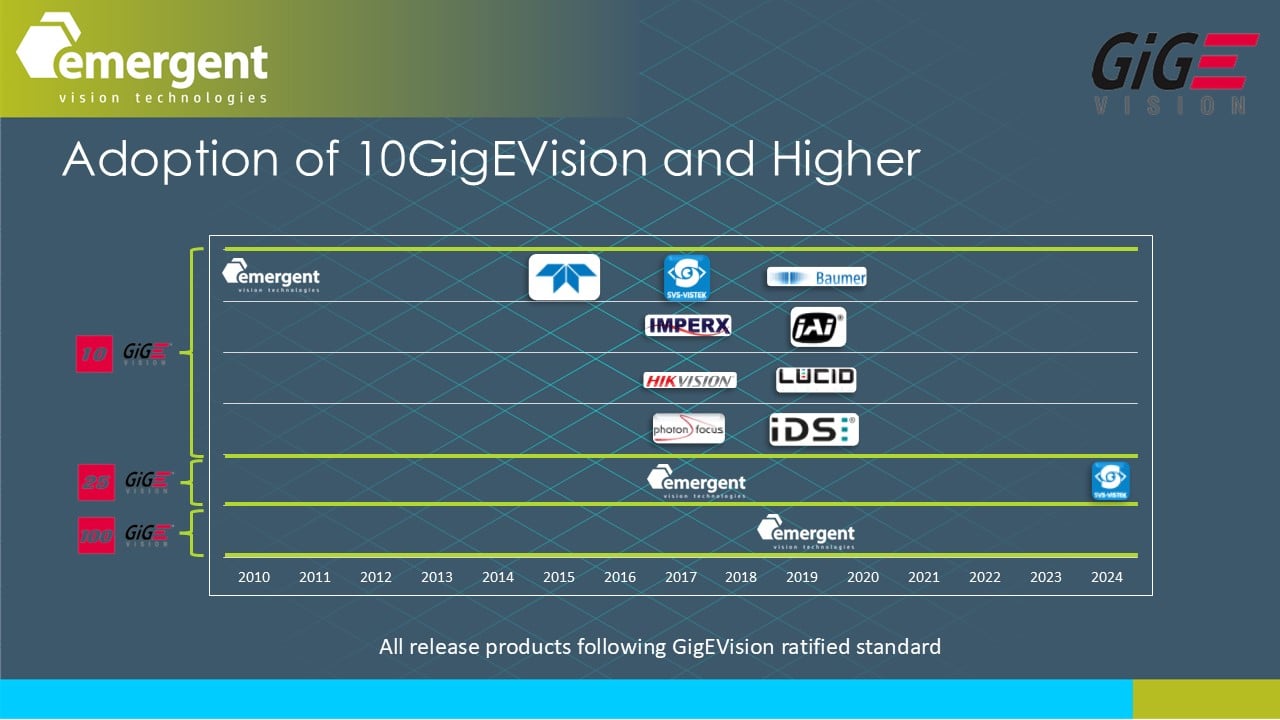
Figure: Emergent Vision Technologies is the first provider of cameras based on 10GigE, 25GigE, 50GigE, and 100GigE interfaces.

